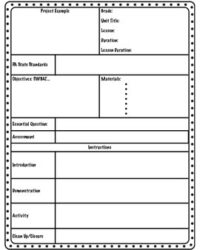Teaching is an art, but like any craft, it benefits immensely from a solid plan. Imagine stepping into a classroom without a clear idea of what you’re teaching, how you’ll teach it, or what you hope your students will achieve. It would be chaos! That’s where a structured approach to lesson planning comes in, providing a roadmap for both you and your students, ensuring that learning objectives are met effectively and efficiently.
Among the myriad of planning methods, the 5 point lesson plan template stands out as a particularly robust and teacher-friendly framework. It breaks down the complexities of a lesson into five digestible, interconnected parts, making it easier to prepare, deliver, and reflect on your teaching. This systematic model helps educators maintain focus, manage time, and cater to diverse learning needs, ultimately leading to more impactful educational experiences.
The Core Components of a 5 Point Lesson Plan
Diving into the specifics of a 5 point lesson plan template reveals its true power in structuring an effective learning journey. Each of the five points serves a crucial purpose, guiding the teacher through the entire instructional process, from initial conceptualization to post-lesson reflection. This comprehensive approach ensures that no stone is left unturned, promoting clarity, engagement, and measurable outcomes in the classroom.
1. Objectives and Learning Goals
This initial point is arguably the most critical. Before you even think about what you’ll teach, you need to define what students should be able to know, understand, or do by the end of the lesson. These objectives should be specific, measurable, achievable, relevant, and time-bound (SMART). Clearly stating these goals at the outset provides direction for your planning and a benchmark for assessing student learning. It’s the compass that guides the entire lesson.
2. Materials and Resources
Once you know where you’re going, you need to gather the tools for the journey. This section outlines all the necessary items: textbooks, worksheets, digital tools, art supplies, manipulatives, or even guest speakers. Thinking through materials in advance prevents disruptions during the lesson and ensures a smooth flow of activities. It’s also an opportunity to consider how different resources can cater to various learning styles.
3. Procedure and Activities
This is the heart of your lesson plan – the “how-to” guide for instruction. It details the step-by-step sequence of events, from how you’ll grab students’ attention at the beginning (the “hook”), through the core instructional strategies, to how you’ll transition between activities. This section often includes:
- Direct instruction: When and how you’ll deliver new content.
- Guided practice: Opportunities for students to practice with support.
- Independent practice: Tasks for students to complete on their own.
- Differentiation strategies: How you’ll support struggling learners and challenge advanced ones.
A well-articulated procedure ensures that the lesson flows logically and engages students throughout.
4. Assessment and Evaluation
How will you know if your students achieved the learning objectives? This point focuses on the methods you’ll use to check for understanding. It could be formal assessments like quizzes, exit tickets, or projects, or informal checks like observing student discussions, asking probing questions, or having students demonstrate skills. This continuous feedback loop is vital for understanding student progress and adjusting your teaching as needed.
5. Reflection and Wrap-up
The lesson doesn’t end when the bell rings. This final component encourages you to look back at the entire process. What worked well? What could be improved for next time? Did all students meet the objectives, and if not, why? This reflective practice is crucial for professional growth, allowing teachers to refine their strategies and make future lessons even more impactful. It completes the cycle of teaching and learning.
Why Embrace the 5 Point Lesson Plan Template in Your Teaching?
Adopting a structured approach like the 5 point lesson plan template offers a multitude of benefits that extend beyond simply organizing your thoughts. It transforms lesson preparation from a daunting task into a strategic exercise, fostering confidence and clarity in the classroom. When you have a clear plan, you can anticipate challenges, allocate time effectively, and focus on interacting with your students rather than scrambling for what’s next.
Using this template empowers teachers to create dynamic and student-centered lessons. It encourages a holistic view of the learning process, prompting consideration of not just what to teach, but how students will learn it, what resources are needed, and how their understanding will be measured. This comprehensive foresight significantly reduces on-the-fly decision-making during class, allowing for a smoother and more confident delivery of content.
Here are some of the key advantages this structure brings:
- Enhanced Clarity: Both for the teacher in planning and for students in understanding expectations.
- Improved Time Management: Helps allocate appropriate time to each segment of the lesson.
- Better Student Engagement: Encourages varied activities and thoughtful sequencing.
- Effective Assessment: Integrates clear methods for checking student comprehension.
- Professional Growth: Fosters reflective practice, leading to continuous improvement in teaching strategies.
Ultimately, a well-crafted 5 point lesson plan template serves as a powerful tool, guiding educators toward more purposeful, engaging, and successful teaching experiences, benefiting both the instructor and the learners.
The journey of teaching is one of constant learning and adaptation, and having a reliable framework can make all the difference. Embracing a systematic approach to lesson design not only streamlines your preparation but also elevates the quality of instruction you provide. It empowers you to enter the classroom feeling prepared, confident, and ready to inspire.
By consistently applying this structured methodology, you’ll find that your lessons become more cohesive, your students more engaged, and your overall teaching experience more rewarding. It’s an investment in your professional practice that pays dividends in the form of improved learning outcomes and a more dynamic educational environment.


